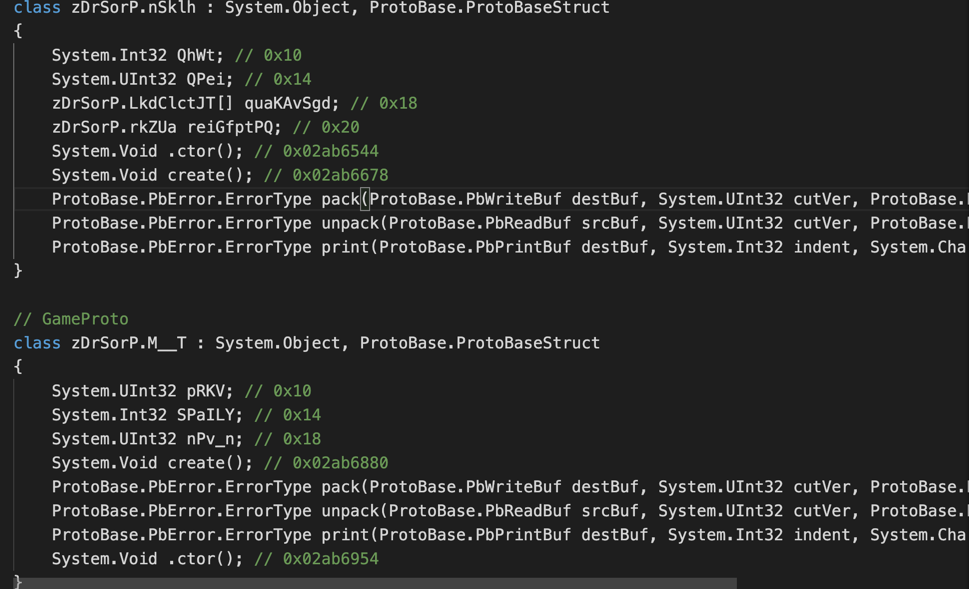前菜
拿到 apk 后直接 unzip 即可解包,解包发现 libil2cpp.so 和 gobal-metadata.dat。但是 global-metadata.dat 的文件头是
0x444F4447,明显被加密了,所以最简单的方法是使用动态方法来解析,其原理可以参考这篇文章。
大体是说所有使用 il2cpp 打包的应用,最后都会留有一些 il2cpp_x 的函数可以作为后门获取整个应用的函数签名及地址。
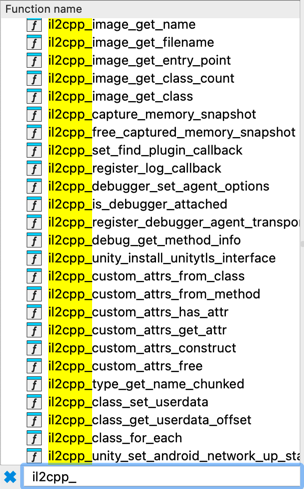
导出 libil2cpp.so 和符号表
导出符号表就比较简单了,直接 npx frida-il2cpp-bridge -U -f xxx dump 就行了。导出的符号表类似这样:
// mscorlib
class System.String : System.Object
{
System.Int32 _stringLength; // 0x10
System.Char _firstChar; // 0x14
static System.String Empty; // 0x0
static System.Boolean EqualsHelper(System.String strA, System.String strB); // 0x03a597f0
}
同时它的 libil2cpp.so 也加密了,需要动态 dump,就稍微写一下脚本问题也不大:
import "frida-il2cpp-bridge";
Il2Cpp.perform(() => {
const m = Process.getModuleByName('libil2cpp.so');
Memory.protect(m.base, m.size, 'rwx');
const buf = Memory.readByteArray(m.base, m.size);
const f = new File('/data/local/tmp/libil2cpp.so', 'wb'); // 注意权限
f.write(buf);
f.close();
console.log('Dump to libil2cpp.so');
});
执行后 so 文件被写到手机本地,使用 adb pull 拉回来即可。导出的 so 如果导入 IDA 打开失败的话,需要使用 SoFixer 修复后再导入。
至此,你已经拥有了 libil2cpp.so 和符号表,接下来就可以使用 IDA 进行反编译了。
开始分析
我的目标是找到网络协议的编码规则。 导出的符号信息里面,我们可以看到基类地址,无论是 Ghidra 还是 IDA 都有 struct 的功能,我们可以手动重建
struct 来实现更可读的逆向代码。首先我找到 NetClient.SendMsg,这看起来就很可疑,直接使用 Frida hook 一下:
Il2Cpp.perform(() => {
const arrayBufferToHex = (buffer) => {
return Array.from(new Uint8Array(buffer))
.map(byte => byte.toString(16).padStart(2, '0'))
.join('');
}
const XXXNative = Il2Cpp.domain.assembly('XXXNative');
const NetClientSendMsg = XXXNative.image.class('XXX.NetClient').method('SendMsg');
NetClientSendMsg.implementation = function (buf, simpleEnc): boolean {
const bufHex = arrayBufferToHex(ptr(buf.elements).readByteArray(buf.length));
console.log('SendMsg:' + bufHex + ', simpleEnc:' + simpleEnc);
return this.method('SendMsg')<boolean>().invoke(buf, simpleEnc);
};
});
这样就可以看到每条发出去的消息,但是存在两个问题:
- 不知道发出去的消息是什么方式编码的;
- 发出去的消息和实际网络里抓包看到的不一样,最后还存在一层加密。

经过一番符号表回填及分析,发现了消息 pack 的方法,即序列化方法,后面只需要把对应的 struct 解出来就行了,这个先放一下,接下来需要找到加密协议

然后继续沿着这个信息走,找到了 simpleEnc 为 true/false 的时候不同的加密方法。首先看比较不 simple 的方法:
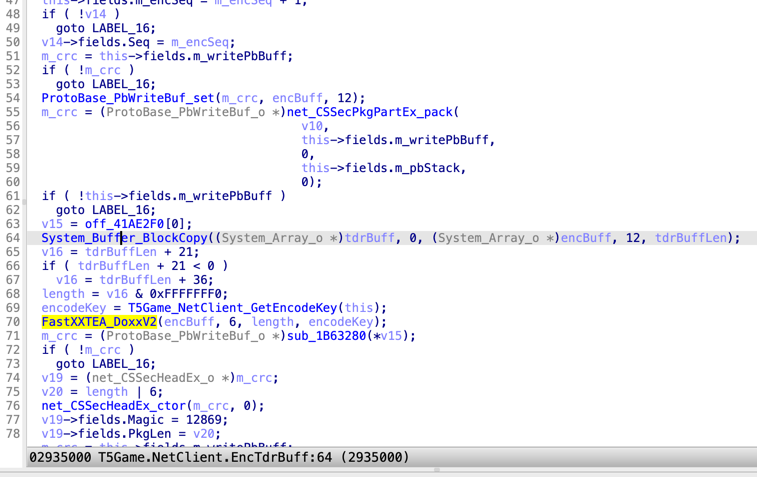
关键是这个加密函数,直接找出来然后自己复原一下。我使用 py 的话需要注意溢出问题,可以使用 np.int32 等类型来模仿溢出行为。另外可以使用 AI,
把反汇编出来的代码让它直接翻译,然后自己再稍微改改就能用,还是挺好用的。
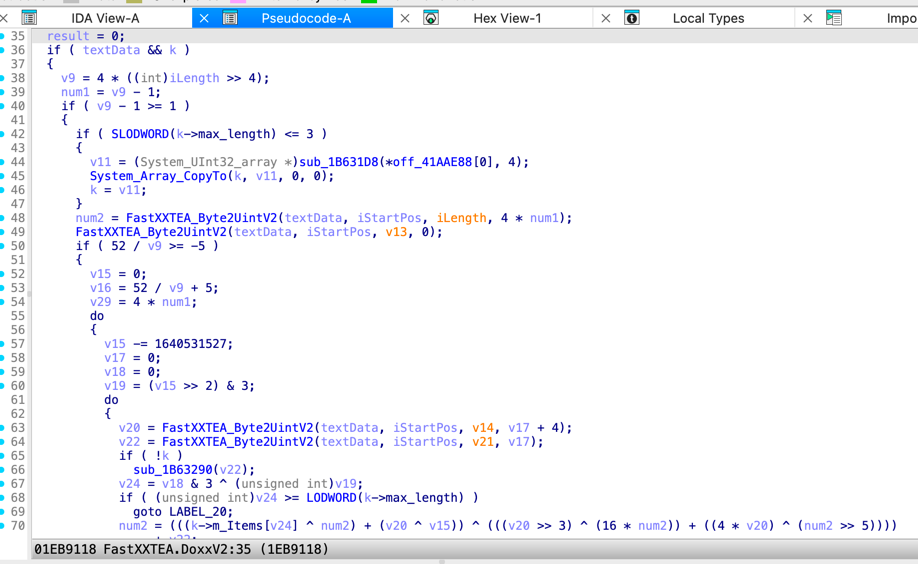
接下来比较头疼的是,接收的信息里面有 cmd id,但是 cmd id 对应会使用不同的 struct 来解析,这需要一个映射表,经过分析它把映射表放到多个函数里, 每个函数里有 20 个 switch 来组成。所以需要解析这个 switch 并拿到对应的 struct。
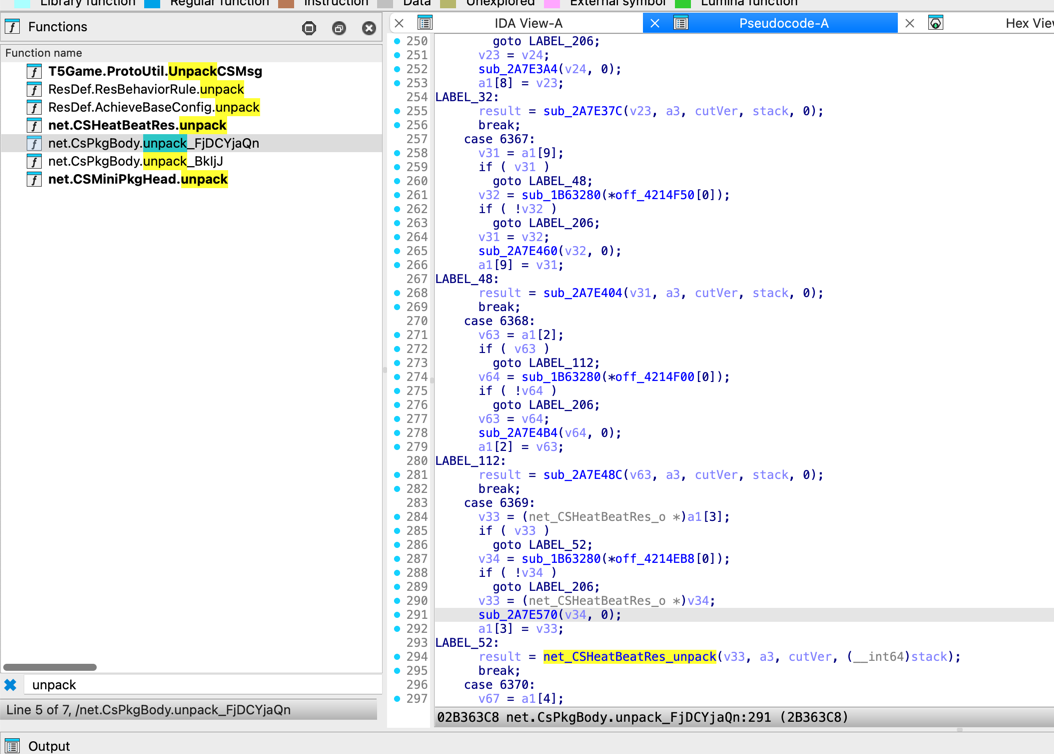
我们可以稍微写点脚本来自动化遍历所有 switch case,新的 IDA 有 ida_hexrays 更方便去获取 switch case 分支不需要管背后的 jtable 了。
import json
import ida_funcs
import ida_hexrays
class CmdIDPackFuncVisitor(ida_hexrays.ctree_visitor_t):
def __init__(self):
ida_hexrays.ctree_visitor_t.__init__(self, ida_hexrays.CV_FAST)
self.cmd_func_map = {}
def visit_insn(self, insn: ida_hexrays.cinsn_t) -> int:
if insn.op == ida_hexrays.cit_switch:
switch: ida_hexrays.cswitch_t = insn.cswitch
cases: ida_hexrays.ccases_t = switch.cases
for case in cases:
cmd_ids: [int] = case.values
blocks: ida_hexrays.cblock_t = case.cblock
for block in blocks:
if block.op == ida_hexrays.cit_expr:
expr: ida_hexrays.cexpr_t = block.cexpr
if expr.op == ida_hexrays.cot_asg:
y: ida_hexrays.cexpr_t = expr.y
if y.op == ida_hexrays.cot_call and y.a.size() > 2:
y_x: ida_hexrays.cexpr_t = y.x
for cmd_id in cmd_ids:
self.cmd_func_map[cmd_id] = y_x.obj_ea
#print(f'Find {','.join(map(lambda x: str(x), cmd_ids))}, unpack by {hex(y_x.obj_ea)}')
return 0
class FuncVisitor(ida_hexrays.ctree_visitor_t):
def __init__(self):
ida_hexrays.ctree_visitor_t.__init__(self, ida_hexrays.CV_FAST)
self.cmd_func_map = {}
def visit_expr(self, expr: ida_hexrays.cexpr_t) ->int:
if expr.op == ida_hexrays.cot_asg:
y: ida_hexrays.cexpr_t = expr.y
if y.op == ida_hexrays.cot_call and len(y.a) == 5:
y_x: ida_hexrays.cexpr_t = y.x
sub_func: ida_funcs.func_t = ida_funcs.get_func(y_x.obj_ea)
sub_cfunc: ida_hexrays.cfuncptr_t = ida_hexrays.decompile_func(sub_func)
if sub_cfunc is None:
raise Exception('decompile func failed')
visitor = CmdIDPackFuncVisitor()
visitor.apply_to(sub_cfunc.body, None)
self.cmd_func_map.update(visitor.cmd_func_map)
return 0
def main():
if not ida_hexrays.init_hexrays_plugin():
raise Exception('hexrays not loaded')
func: ida_funcs.func_t = ida_funcs.get_func(0x2B20104)
if func is None:
raise Exception
func_ptr: ida_hexrays.cfuncptr_t = ida_hexrays.decompile_func(func)
if func_ptr is None:
raise Exception('decompile func failed')
visitor = FuncVisitor()
visitor.apply_to(func_ptr.body, None)
msg_map = dict(sorted(visitor.cmd_func_map.items()))
print(len(msg_map))
print(json.dumps(msg_map))
if __name__ == "__main__":
main()
通过这个脚本,我们找到了所有 cmd_id 的 pack function 了,但遗憾地,原始的符号表就已经混淆了防了一手。好在我拿到旧版本的 apk,发现它的不仅 没有加密 global-meta,符号表也是没有混淆的。如果找不到这一步,那只能更费力地去推测每个字段的含义。
